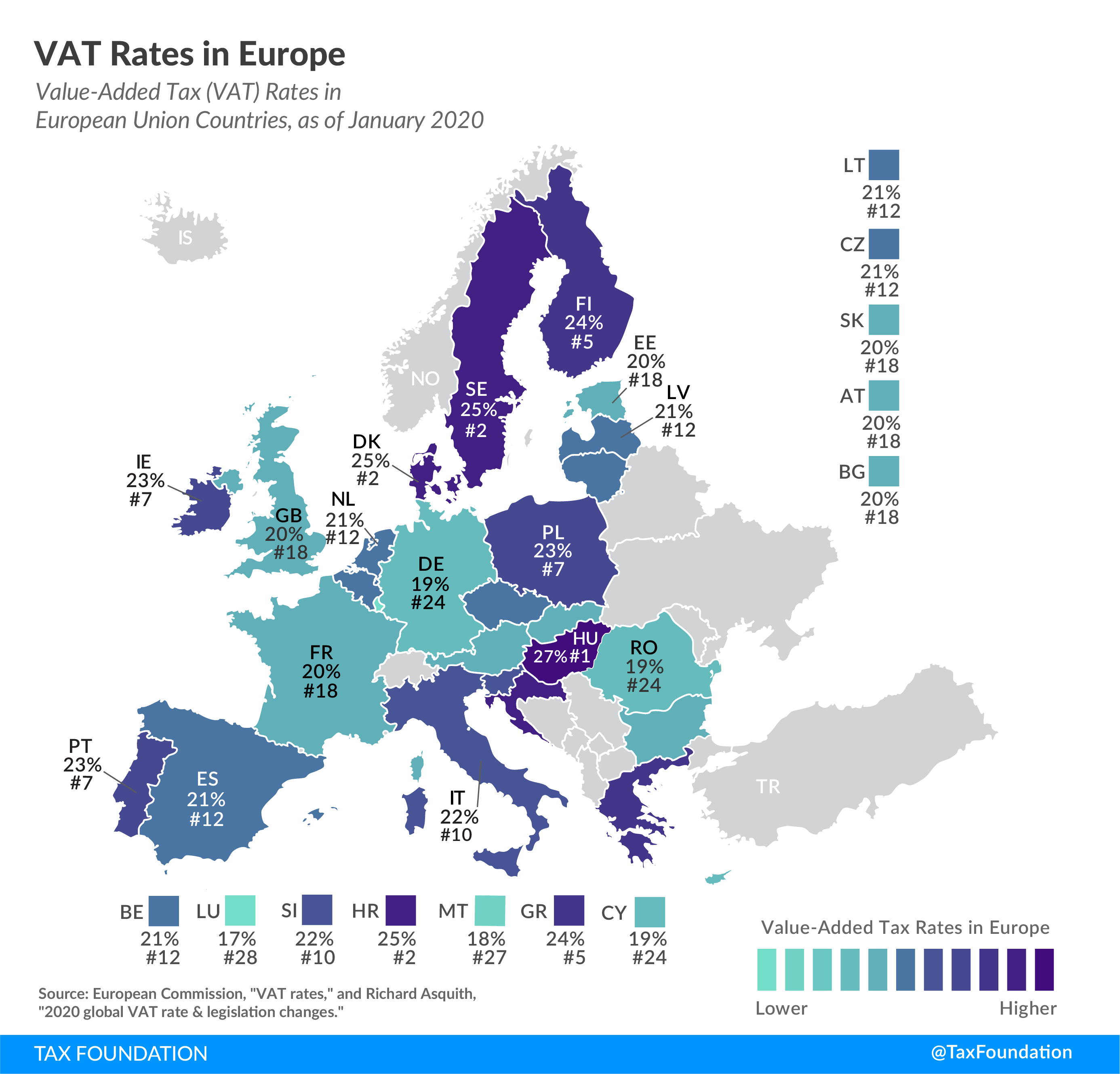
VAT Rates in Europe, 2020
4 min readBy:More than 140 countries worldwide—including all European countries—levy a Value-Added Tax (VAT) on purchases for consumption. As today’s tax map shows, although harmonized to some extent by the European Union (EU), EU member states’ VAT rates vary across countries.
The VAT is a consumption tax assessed on the value added to goods and services. The final VAT levied on a good or service is the sum of the VAT paid at each production stage. While VAT-registered businesses can deduct all the taxA tax is a mandatory payment or charge collected by local, state, and national governments from individuals or businesses to cover the costs of general government services, goods, and activities. already paid in the preceding production stages, the end consumer does not receive a credit for the VAT paid, making it a tax on final consumption.
The EU countries with the highest standard VAT rates are Hungary (27 percent), and Croatia, Denmark, and Sweden (all at 25 percent). Luxembourg levies the lowest standard VAT rate at 17 percent, followed by Malta (18 percent), and Cyprus, Germany, and Romania (all at 19 percent). The EU’s average standard VAT rate is 21 percent, six percentage-points higher than the minimum standard VAT rate required by EU regulation.
Generally, consumption taxes are an economically efficient way of raising tax revenue. To minimize economic distortions, there is ideally only one standard rate that is levied on all final consumption, with as few exemptions as possible. However, EU countries levy reduced rates and exempt certain goods and services from VAT.
One of the main reasons for reduced VAT rates and VAT exempted goods/services is the promotion of equity, as lower-income households tend to spend a larger share of income on goods and services such as food and public transport. Other reasons include encouraging the consumption of “merit goods” (e.g., books), promoting local services (e.g., tourism), and correcting externalities (e.g., clean power).
However, an OECD study has found that reduced VAT rates and VAT exemptions are not effective in achieving these policy goals and can even be regressive in some instances. Such reduced rates and exemptions can lead to higher administrative and compliance costs and can create economic distortions. To address equity concerns, the OECD instead recommends measures that directly aim at increasing poorer households’ real incomes.
|
Note: When one of the major EU VAT directives was adopted in 1991, some EU countries were applying reduced, super-reduced or zero rates to goods and services that were not specified by the new regulations as falling within the zero-rate or reduced rate categories. To ease the transition to a standard rate on these goods and services, a so-called “parking rate” was permitted. Although it was intended to be phased out, some countries still apply it. Source: European Commission, “VAT rates,” https://ec.europa.eu/taxation_customs/business/vat/eu-vat-rules-topic/vat-rates_en, and Richard Asquith, “2020 global VAT rate & legislation changes,” Avalara, Jan. 1, 2020, https://www.avalara.com/vatlive/en/vat-news/2020-vat-rate-changes.html. |
||||
| Country | Super-reduced Rate (%) | Reduced Rate (%) | Parking Rate (%) | Standard Rate (%) |
|---|---|---|---|---|
| Austria (AT) | – | 10 / 13 | 13 | 20 |
| Belgium (BE) | – | 6 / 12 | 12 | 21 |
| Bulgaria (BG) | – | 9 | – | 20 |
| Croatia (HR) | – | 5 / 13 | – | 25 |
| Cyprus (CY) | – | 5 / 9 | – | 19 |
| Czech Republic (CZ) | – | 10 / 15 | – | 21 |
| Denmark (DK) | – | – | – | 25 |
| Estonia (EE) | – | 9 | – | 20 |
| Finland (FI) | – | 10 /14 | – | 24 |
| France (FR) | 2.1 | 5.5 / 10 | – | 20 |
| Germany (DE) | – | 7 | – | 19 |
| Greece (GR) | – | 6 / 13 | – | 24 |
| Hungary (HU) | – | 5 / 18 | – | 27 |
| Ireland (IE) | 4.8 | 9 / 13.5 | 13.5 | 23 |
| Italy (IT) | 4 | 5 / 10 | – | 22 |
| Latvia (LV) | – | 5 / 12 | – | 21 |
| Lithuania (LT) | – | 5 / 9 | – | 21 |
| Luxembourg (LU) | 3 | 8 | 14 | 17 |
| Malta (MT) | – | 5 / 7 | – | 18 |
| Netherlands (NL) | – | 9 | – | 21 |
| Poland (PL) | – | 5 / 8 | – | 23 |
| Portugal (PT) | – | 6 / 13 | 13 | 23 |
| Romania (RO) | – | 5 / 9 | – | 19 |
| Slovakia (SK) | – | 10 | – | 20 |
| Slovenia (SI) | – | 9.5 | – | 22 |
| Spain (ES) | 4 | 10 | – | 21 |
| Sweden (SE) | – | 6 / 12 | – | 25 |
| United Kingdom (GB) | – | 5 | – | 20 |






